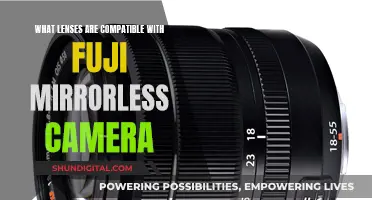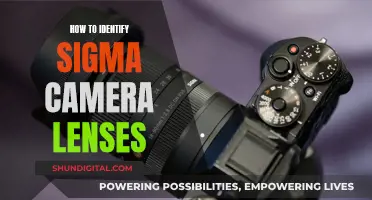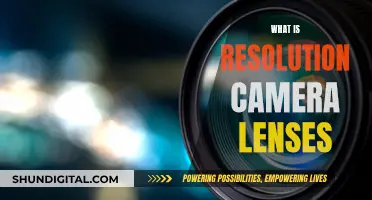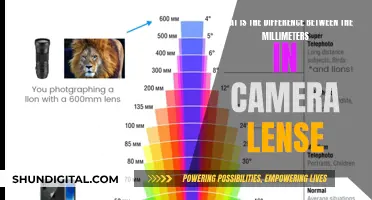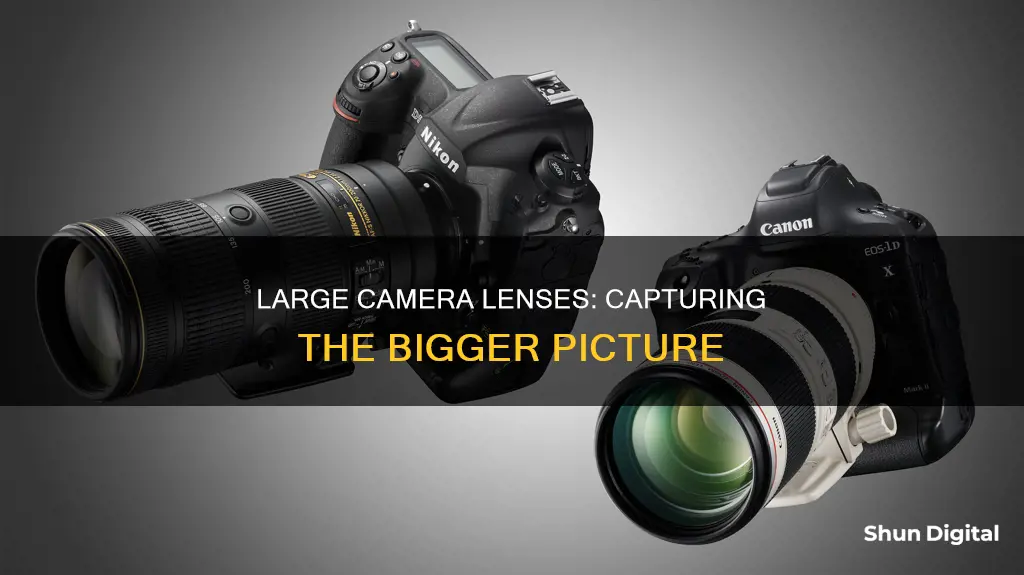
Large camera lenses are used to capture images of distant subjects, most commonly in wildlife and sports photography. They are also used in portraiture, flattering subjects and separating them from their backgrounds. They are known as telephoto lenses and are typically bulky and heavy, requiring a tripod for support. They are often used by professional photographers and can be expensive. Large camera lenses have a long focal length, which determines the angle of view and the magnification of the subject. They are usually zoom lenses, which allow photographers to change the focal length within a predefined range, making them more flexible than prime lenses.
| Characteristics | Values |
|---|---|
| Purpose | To focus light from what you see through the viewfinder into a tiny, typically 35mm spot on the back of your camera. |
| Use | Wildlife photography, sports photography, portraiture, landscape photography, architecture photography |
| Focal length | Longer focal lengths for telephoto lenses, shorter focal lengths for wide-angle lenses. |
What You'll Learn

Large camera lenses are used for wildlife photography
Large camera lenses are often used for wildlife photography, where the right lens can make a big difference. Wildlife photography comes with its own set of challenges, such as the distance of the subject and lighting conditions. Here are some reasons why large camera lenses are useful for wildlife photography:
Versatility
Zoom lenses offer a range of focal lengths, allowing for more flexibility in capturing different compositions. They are also more affordable than prime lenses, which have fixed focal lengths. This makes zoom lenses a popular choice for wildlife photography, as they can be used to photograph a variety of animals, from small birds to large mammals, at different distances.
Image Quality
While prime lenses often offer better image quality and faster apertures, recent advancements have narrowed the gap. Modern zoom lenses, such as the Sony 200-600mm and Canon 100-500mm, deliver impressive image quality even at their maximum focal length, providing sharp images with minimal softness.
Portability
Large camera lenses for wildlife photography come in a range of sizes and weights. While some heavier lenses may require a tripod or monopod for extended periods of use, others are designed to be lightweight and handheld. This portability is essential for wildlife photographers who need to travel long distances or react quickly to capture spontaneous shots.
Budget Options
Large camera lenses for wildlife photography cater to various budgets. While some lenses can be extremely expensive, there are also budget-friendly options available. For example, the Sigma 150-600mm f/5-6.3 is a popular choice for those on a tighter budget, offering good image quality at a more affordable price.
Autofocus and Image Stabilization
Large camera lenses often feature advanced autofocus systems, ensuring fast and accurate focusing. Additionally, many lenses are equipped with image stabilization technology, enabling sharp images even at slower shutter speeds. These features are particularly useful for wildlife photography, where capturing clear, focused shots of moving subjects is crucial.
What Shape Makes Camera Lenses Work?
You may want to see also

They are useful for sports photography
Large camera lenses are useful for sports photography as they can capture fast-paced sporting action from a distance. The ideal lens for sports photography will be fast, with a large maximum aperture to allow for faster shutter speeds and better low-light performance. The lens should also have a long focal length, or telephoto, to capture close-up vignettes of distant action.
The 70-200mm lens is the classic focal length for sports photography and is used by almost every professional sports photographer. It is fast, has a versatile focal length, and is good for almost any sport. However, for sports such as football and soccer, a longer lens of 100-400mm is recommended to capture the large field of play. For sports played indoors or at closer distances, such as basketball and tennis, shorter focal-length prime lenses and zoom lenses can also be effective.
When choosing a lens for sports photography, it is important to consider the specific sport and the distance from the action. A zoom lens of up to 400mm can offer more versatility, while a blend of zooms and long, fast telephoto primes is often chosen by professional sports photographers.
Some recommended lenses for sports photography include:
- Canon RF 70-200mm f/2.8 L
- Nikon Z 70-200mm f/2.8
- Sony FE 70-200mm f/2.8
- Sigma 70-200mm f/2.8 DG DN OS Sports
- Fujifilm XF 50-140mm F/2.8
- Panasonic Lumix G X Vario 35-100mm F2.8
Creating Realistic Camera Lenses in Illustrator
You may want to see also

They can be used for portraiture
Large camera lenses can be used for portraiture. Here are some reasons why:
- Large camera lenses are great for portraiture as they have wider maximum apertures, which create blurrier backgrounds and allow you to better isolate and highlight your subject.
- They have fixed focal lengths, meaning the only way to change the size of your image is to physically move closer to or farther from your subject.
- Prime lenses produce a sharper, better-quality image, and the sacrifice of zooming is well worth it in terms of photo quality.
- 50mm lenses are good for full-length and waist-length portrait photos, both on location and in the studio. They have a wide field of view, which allows you to stand close to your subject while capturing more of their body and background.
- 135mm lenses are a high-grade option for professional portrait photographers, with a longer focal length that’s especially good for on-location settings.
- 85mm lenses are the most popular kind of lens for portrait photography, combining the advantages of both the 50 and 135mm lenses. This lens allows you to keep a reasonable working distance from your subject with a narrower field of view for better focus.
Camera Lenses: Is Price Tag Directly Linked to Quality?
You may want to see also

They are good for landscape photography
Large camera lenses are great for landscape photography. They can help you capture incredible sweeping scenes in pin-sharp detail.
Wide-angle lenses are a must-have for landscape photographers. They have a wider focal field, allowing you to capture more of the scene in front of you than a zoom lens. This makes them perfect for photographing landscapes and architecture, as you can capture more of the scenery and building. Wide-angle lenses generally have a focal length between 16 and 35mm.
Telephoto lenses also have a place in landscapes and architecture, providing a very different perspective than wide-angle lenses. They let you fill the frame with distant subjects, so they are most commonly used for wildlife and sports photography. However, their narrow perspective can be handy for landscapes, too.
If you're looking for a lens that will help you capture stunning landscape photos, a wide-angle lens is a great option. They allow you to capture more of the scene in front of you, making them perfect for landscapes and architecture. Telephoto lenses can also be used for landscapes, providing a different perspective that can be useful in certain situations.
When choosing a lens for landscape photography, it's important to consider your goals and the specific type of landscape you want to capture. If you want to capture a wide, sweeping scene, a wide-angle lens is a better choice. If you want to focus on a specific element in the distance, a telephoto lens might be a better option.
Additionally, the weight of the lens can be an important factor, especially if you plan to hike or travel with your gear. Wide-angle lenses tend to be smaller and lighter than telephoto lenses, making them easier to carry.
Ultimately, the best lens for landscape photography depends on your specific needs and preferences. Both wide-angle and telephoto lenses can be used to capture stunning landscape photos, so consider the type of scenes you want to capture and choose a lens that will help you achieve your creative vision.
Traveling with Camera Lenses: A Comprehensive Guide for Photographers
You may want to see also

They are used for architecture photography
Large camera lenses are used for various types of photography, including sports, wildlife, and architecture. In architecture photography, large lenses are used to capture images of buildings and interior spaces.
When photographing architecture, it is important to have a lens that can capture wide-angle shots, as well as detailed shots. Wide-angle lenses have a wider field of view, allowing photographers to capture more of the scene in front of them, which is ideal for photographing buildings and interiors. Tilt-shift lenses are also commonly used in architecture photography as they allow photographers to adjust the perspective and correct converging parallel lines without moving the camera.
For Canon users, the Canon TS-E 90mm f/2.8 is a popular tilt-shift lens that enables control over the orientation of the plane of focus. The Canon 16-35mm f4L IS Lens is another recommended lens for architecture photography, offering a wide-angle view and the ability to focus on details.
For Nikon users, any camera with a resolution above 25MP is suitable for architecture photography. The Nikon AF-S 24-70mm f/2.8G ED VR II is a versatile lens that can be used for both wide-angle and detailed shots.
Other manufacturers also offer lenses suitable for architecture photography, such as the Laowa 12mm f/2.8, which has no visible distortion and good imaging performance. It is important to note that the ideal lens may vary depending on the specific requirements of the photographer and the type of architecture being captured.
Cracking Camera Lenses: A Step-by-Step Guide to Mastery
You may want to see also
Frequently asked questions
Large camera lenses, also known as telephoto lenses, are used to capture distant subjects and bring them closer to the frame. They are commonly used in wildlife and sports photography but can also be used for portraiture, landscapes, and architecture.
A zoom lens allows the photographer to vary the focal length within a predefined range, offering more flexibility in capturing different subjects or scenarios.
A prime lens has a fixed focal length, meaning it cannot zoom in or out. Prime lenses are typically more affordable, lighter, and faster than zoom lenses, making them a popular choice for photographers.
Wide-angle lenses have shorter focal lengths, allowing for a wider field of view, while telephoto lenses have longer focal lengths, bringing distant subjects closer.
Large camera lenses are typically used by professional photographers due to their cost, bulk, and specialised use. However, advancements in technology have made them more accessible to amateur photographers as well.


